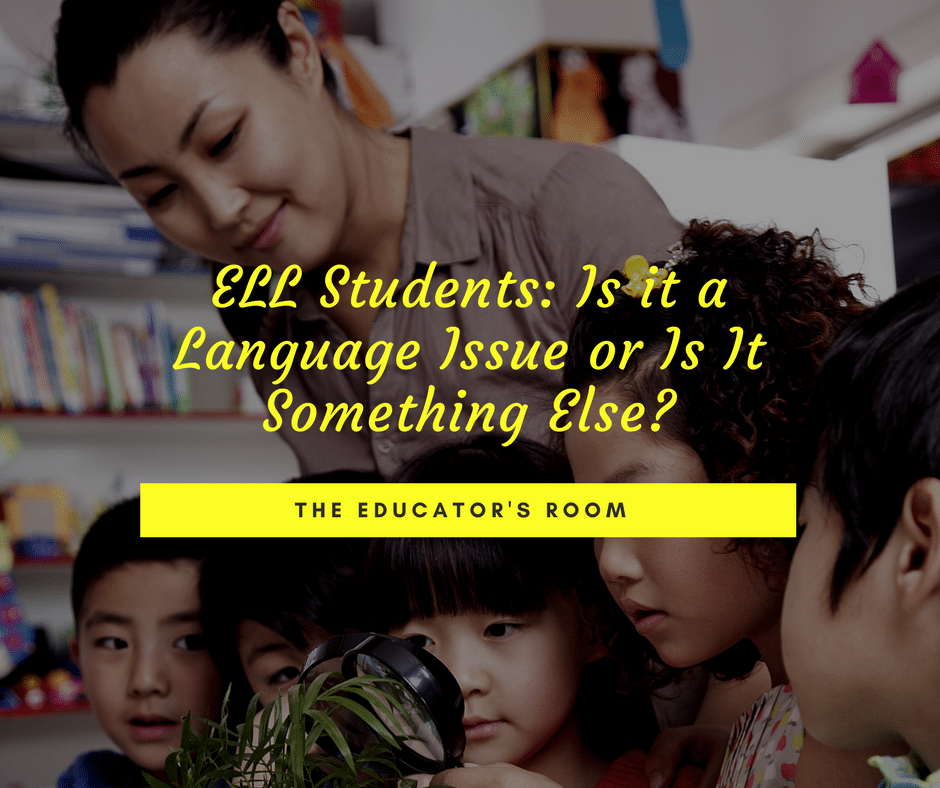Teachers of English Language Learners (ELLs) may face a challenge when deciding if their students struggle with language or other learning issues. The difference can be hard to identify. As a bilingual and ELL teacher, I ran into many students who struggled in class. I wondered how I could reach them and keep the momentum going for further lessons. Many times my struggling ELL students seemed to make progress and then regressed. First, I needed to make sure I understood why my ELL student was not reaching the objectives.
Identifying the problem took one-on-one effort and sheltered instruction. When I say sheltered instruction, I mean supports for the students. It’s presenting the material in a concrete way that makes the objective of the lesson accessible to everyone in my class. I used visuals, labeling, matching, fill-in-the-blank, one-on-one time, pre-teaching and so on. I realized that maybe I needed to step back and reflect. My expectations had to be aligned with what my ELL student could produce. I could not expect elaborate sentences from a student speaking broken English. I should expect all students to use my sentence stems. A few questions I needed to ask myself were:
What can I expect from an ELL at that level?
What strategies have I used?
A good resource is the WIDA descriptors.
Example of ELL Supports
When I taught a lesson on inferencing, I started with a magnifying glass and putting clues together. The clues were all in picture format so that the students did not need written language to come up with their inferences. I then moved on into using a book way below grade level to teach inferencing. I gave the students sentence stems so that they could produce language. When all the students worked on my exit slip, each of them were able to write something. My struggling ELL felt empowered when she was able to successfully connect to the lesson before the text became too difficult.
Realistic expectations are key. When working with ELLs who speak nearly no English, any production of language might feel like a stretch for them. They might need fill in the blank with a word bank, matching or multiple choice with simplified language and picture assistance.
When a student didn’t meet objectives, I would ask them to talk through their thinking. Sometimes, there were lots of pointing on their part and labeling on my part. Students could catch their error while doing this. When no conversation was produced, I needed to reteach the lesson with lots visual support and simplified language. My struggling ELL needed the lesson repeated and simplified language. Your ELL should be able to repeat language and recall what was just taught one-on-one. If not, your issue is something else.
According to Leonard Baca, a bilingual/ESL special education specialist, we need to “effectively distinguish between language acquisition and learning disabilities” (Baca, n.d.). Our ELLs with no learning disabilities will be able to proceed with sheltered instruction. They will show an ability to meet most objectives with supports. When the student consistently struggles to respond even with visuals, simplified language and in a small group setting consistently, there is another issue. This child could have vision issues, a learning disability or needs more time building their background knowledge.
Background Knowledge
There are so many different backgrounds in our classroom. As teachers, we can’t assume we know what the student will understand without entering their world. They come to us with a wealth of experiences. We need to tap into it in order to teach them properly. Even with visual clues, students may not understand because they don’t have the experience to connect to what we are teaching. This required me to frequently check in with my ELLs to have them talk to me about their understanding. I also needed to simply connect with them on a more personal level. This might mean taking out pictures and asking them what the picture brings to mind. It could mean, I needed to make a phone call home just to get to know the parents. It might mean, I need to see if there is anyone in the school or district who could speak the same language as my student. This is extremely telling of whether it is a language issue, a learning disability or a lack of background.
[bctt tweet=”Students come to us with a wealth of experiences. ” username=”EducatorsRoom”]
As time went on, I would provide less support and see whether my ELL was able to still meet the objectives. For example, If I had given fill-in-the-blank exit slips, I would switch to giving the students sentence stems to start the sentences and a general word bank. It’s only the slightest difference, but we know that success breeds more success. If that child felt confident in what they achieved, they would be more willing to take risks. That student takes a risk each time he or she speaks. The supports came off slowly. In my experience, most ELLs will thrive after a few months of support and interaction with their peers. ELLs who didn’t thrive with sheltered instruction and realistic expectations needed interventions beyond what I could provide in my classroom alone.
References
http://www.ets.org/Media/Conferences_and_Events/pdf/ELLsympsium/Baca_Leonard.pdf
http://www.cal.org/siop/pdfs/briefs/using-sheltered-instruction-to-support-english-learners.pdf






